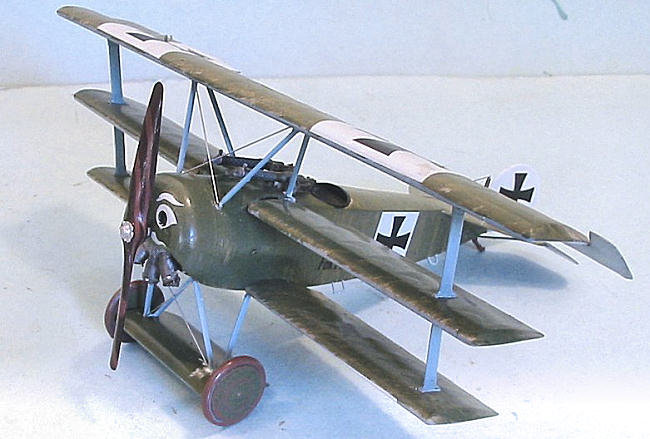
| KIT #: | 605 |
| PRICE: | $42.95 MSRP |
| DECALS: | Four options |
| REVIEWER: | Tom Cleaver |
| NOTES: |

| HISTORY |
By 1917, Tony Fokker was looking for a way back into the game, since his D.II‑D.V series of fighting biplanes had been deemed unacceptable for operational use due to shoddy construction at the factory, and been relegated to second‑line and training duties.
That Spring, the appearance of the Sopwith Triplane would have an effect on Idflieg, the German air command, similar to that of the Nieuport sesquiplane the year before ‑ in which every German fighter became a sesquiplane whether they should have been or not, in an attempt to match the Nieuport's performance. The same would happen with the Sopwith Triplane, and result in the appearance that summer of the Fokker Triplane, which is arguably one of the most famous fighters of the First World War, even if it was not really that good an airplane. Even the legendary triplane maneuverability of the Fokker was not as good as that of the Sopwith product, due to the fact the Fokker only had ailerons on the upper wing, rather than all three wings like the Sopwith.
In July, 1917, Fokker built three pre‑production triplanes, designated the F.1 (the production triplane would be known as the Dr.I.) The F.1 differed in several details from the later production‑standard Dr.I, most noticeably the fact that the leading edge of the horizontal stabilizer was curved, rather than straight, and the ailerons had slightly less area in planform with larger “ears.” Also, the cowling had a higher "lip" than the later cowlings.
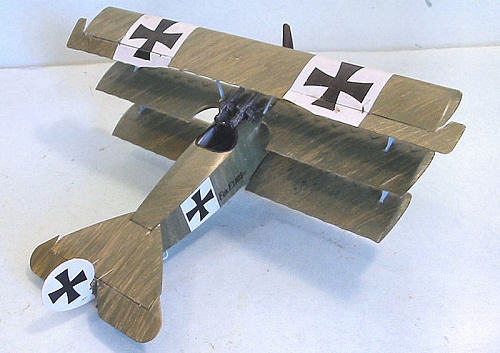 Two
F.1s were presented to Jasta 2; F.1/102 was used by Manfred von Richtofen only a
few times before he was wounded in combat in August 1917, and one was provided
to Werner Voss, who put his to very good use indeed. In the first 10 days of
August, he scored five victories, with four more by the end of the month.
Two
F.1s were presented to Jasta 2; F.1/102 was used by Manfred von Richtofen only a
few times before he was wounded in combat in August 1917, and one was provided
to Werner Voss, who put his to very good use indeed. In the first 10 days of
August, he scored five victories, with four more by the end of the month.
By September 10, he had scored 5 more in two combats. It is today unclear if all those victories were in fact scored with the triplane, since records show that the airplane suffered from numerous “glitches” as would be expected of a new type. Some authorities believe he may have shot down as few as three enemy aircraft with the triplane. Nevertheless, the story of Werner Voss is an enduring piece of Great War mythology, and his Fokker F.1 is exceeded in fame only by the Fokker Dr.I in which his commanding officer, Manfred von Richtofen, would die in less than seven months later.
The Legendary Werner Voss:
Of the German aces the fighter pilots of the Royal Flying Corps faced on the Western Front, few were more respected than Leutnant Werner Voss, who began his career as a fighter pilot in November 1916 with the legendary Jasta 2 "Boelcke," and ended it ten months later as Commanding Officer of Jasta 10, a winner of the "Pour le Merite" ‑ also known as "The Blue Max" ‑ and 48 victories, all scored on the Somme Front. His career was the stuff of legend, the veritable model for the World War I flying ace of the pulp novels a new generation of fighter pilots would read as youths in the 1920s and 1930s.
As if his career was not enough, his death was even more legendary. He had been sent home for a rest in mid-September which turned out to be one of Tony Fokker's continuous parties in Berlin, this one to celebrate Bruno Loerzer's "Blue Max". He returned to the front on September 23.
On September 23, 1917, having just scored his 48th victory on a previous patrol, he set out at dusk with the goal of gaining two more victories to bring his score to an even 50.
North of Frezenberg, Voss dove his Fokker F.1 triplane on an S.E.5a. At that moment, RFC ace Capt. James B. McCudden ‑ commander of 56 Squadron ‑ spotted the triplane diving on the S.E. 5a and turned with his wingman, Lieutenant Albert Rhys‑Davids, to give help as the other four 56 Squadron aircraft turned to follow. Voss turned from his intended victim and gavebattle to the group of 56 Squadron aces. After a few minutes, he was joined by a red‑nosed Albatros D.V, which tried to cover him.
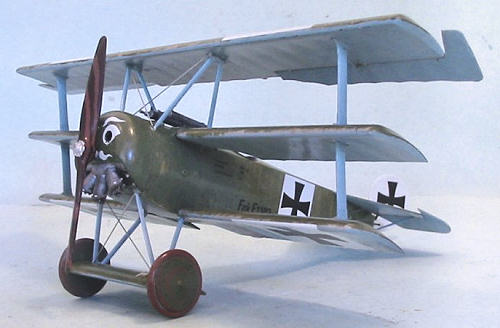 During the
next ten minutes, Voss outflew his seven opponents, shooting down two and
damaging the other five as the British pilots felt they were fighting for their
lives. Finally, afterreloading his Lewis gun for the third time, Rhys‑Davids
managed to hold the triplane in his sights long enough to fire off a fourth
97‑round drum and almost all the ammo for his Vickers.
During the
next ten minutes, Voss outflew his seven opponents, shooting down two and
damaging the other five as the British pilots felt they were fighting for their
lives. Finally, afterreloading his Lewis gun for the third time, Rhys‑Davids
managed to hold the triplane in his sights long enough to fire off a fourth
97‑round drum and almost all the ammo for his Vickers.
Rhys‑Davids reported, "He made an attempt to turn and we were so close I was certain that we would collide. He passed my starboard wing by inches and went down. I saw him next with his engine apparently out, gliding east. I dove, and got one final burst. I overshot him, zoomed, but never saw him again."
McCudden reported, "I saw him go into a fairly steep dive and so I continued to watch, and then saw the triplane hit the ground and disappear into a thousand fragments, for it seemed to me that it literally went into powder. His flying was wonderful, his courage magnificent, and in my opinion he is the bravest German airman whom it has been my privilege to see fight." Rhys‑Davids held his opponent in such respect that he said upon learning it was Voss, "If I could only have brought him down alive."
There has long been controversy whether Voss was actually shot down and killed by the aces of 56 Squadron or whether he was the victim of the small fuel supply of the Triplane and ran out of gas, which led to his being shot up and damaged as he attempted to glide for safety, with a fatal crash landing. As with other legendary aces like France’s Georges Guynemer and America’s Frank Luke, the truth will never be known since Voss crashed into No Man’s Land where he and his airplane were destroyed by shelling.
| THE KIT |
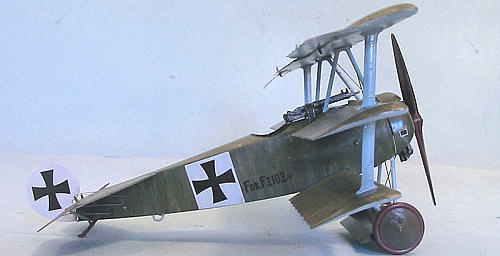 It
was apparent looking in the box last year when Roden released their Fokker Dr.I
that an F.1 would be released, since there were alternative parts for the
ailerons and the horizontal stabilizer, the two most-obvious visual differences
between the two types. This kit differs from that earlier release only in
providing the decals for all three of the Fokker F.1s, as well as the immediate
V4 prototype of the Dr.I, with the instructions telling the modeler to use the
ailerons and stabilizer meant for the F.1.
It
was apparent looking in the box last year when Roden released their Fokker Dr.I
that an F.1 would be released, since there were alternative parts for the
ailerons and the horizontal stabilizer, the two most-obvious visual differences
between the two types. This kit differs from that earlier release only in
providing the decals for all three of the Fokker F.1s, as well as the immediate
V4 prototype of the Dr.I, with the instructions telling the modeler to use the
ailerons and stabilizer meant for the F.1.
This kit is, to my knowledge, the only mainstream injection-molded kit of the Fokker F.1 other than the Eduard 1/72 kit. While the Eduard kit was merely a Dr.I with the decals to do Voss’ F.1, and needed either some substantial scratchbuilding or the Roseplane resin parts - or both in order to become an actual Fokker F.1, Roden has supplied additional parts. Unfortunately, even with these, they still haven’t gotten things completely right, though the effort to modify these parts to accurately portray the F.1 is not difficult.
| CONSTRUCTION |
Construction is not different from that which I outlined in my Dr.I review , or that Scott recounts in his review , other than to work on the correction of the parts to make the kit into a model of the Fokker F.1.
 First and foremost, the ailerons - while having the proper surface for most of
their structure - do not provide the larger counterbalanced “ears” of the F.1
ailerons. This is easy to solve, since you need only cut off the “ears” from the
ailerons you won’t use, and graft them onto the F.1 ailerons. An application of
Mr. Surfacer and a few minutes with a sanding stick turn them into the correct
ailerons with little trouble.
First and foremost, the ailerons - while having the proper surface for most of
their structure - do not provide the larger counterbalanced “ears” of the F.1
ailerons. This is easy to solve, since you need only cut off the “ears” from the
ailerons you won’t use, and graft them onto the F.1 ailerons. An application of
Mr. Surfacer and a few minutes with a sanding stick turn them into the correct
ailerons with little trouble.
The other item that needs a small modification is the cowling. The F.1 has a prominent lip on the open lower area of the cowling, which can easily be made with evergreen sheet as I did. (Another alternative is the Cutting Edge conversion set if you don't feel like doing it yourself. Ed)
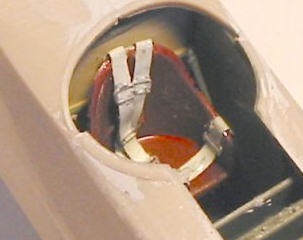 Past
these changes, my only deviation from the construction of the earlier kit was to
leave out the interior parts that cannot be seen once the fuselage is assembled,
merely as a way to avoid work on things unseen and therefore (to me)
unnecessary, since I firmly believe in the philosophy of “if you can’t see it, I
didn’t do it.”
Past
these changes, my only deviation from the construction of the earlier kit was to
leave out the interior parts that cannot be seen once the fuselage is assembled,
merely as a way to avoid work on things unseen and therefore (to me)
unnecessary, since I firmly believe in the philosophy of “if you can’t see it, I
didn’t do it.”
One small but important point to stress is that when it comes time to attach the interplane struts, be sure you have scraped out and slightly enlarged the cutouts in the center wing, so that the one piece strut can slide easily into position. If you don’t do this, it’s easy to break the strut trying to force it, or to end up with it incorrectly located, which leads to all kinds of problems in further construction.
As is usual with a Fokker Triplane, I stopped construction once I had the separate assembly of the fuselage and wings finished, to proceed with painting and decaling.
| COLORS & MARKINGS |
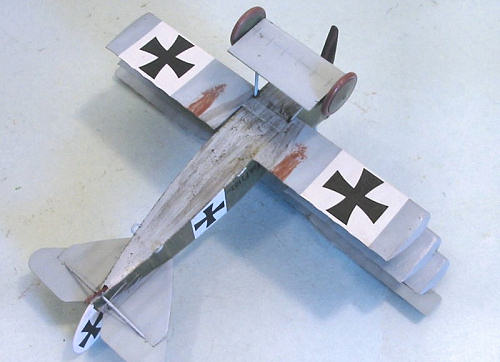 Painting:
Painting:
I used Xtracrylix paints for this project. The lower surfaces were painted with RLM65 “Hellblau,” which I think is the “turquoise blue” color mentioned in World War I. The upper surfaces were painted with “Gulf War Armor Tan,” which is a good substitute for Clear Doped Linen, while the green camouflage was done with “RLM62" Green, which is a more greenish olive green, which looks right when compared with new research about what this color actually was on Fokker airplanes. As is also usual, after I had painted the model blue and tan, I gave all the parts a coat of clear lacquer, so that they would not be affected when I brushed on the thinned green paint. I used a flat tip brush about 1/4 inch wide to do this, with the paint thinned 30 percent with Xtracrylix thinner.
Decals:
Roden’s decals are excellent now, with the white bands being opaque enough to go over dark colors without any “bleed-through.” The decals snugged down under Micro-Sol with no problems. Once everything had set, I washed the parts to get rid of residue, then gave everything a coat of Xtracrylix Satin Varnish, which gives a “scale look” to a gloss finish to my eye.
| FINAL CONSTRUCTION |
I followed the instructions for assembly, posing the control surfaces in “dynamic” positions that correlated to the positions I had set the controls in when assembling the cockpit. Rigging is very easy for this kit, and I used .008 steel wire for the minimal bracing and control wires. I weathered the model by hand-painting Tamiya “Smoke” on the bottom of the fuselage to simulate the residue of castor oil from a rotary engine, with some mud smears on the lower wing kicked up by the wheels.
| CONCLUSIONS |
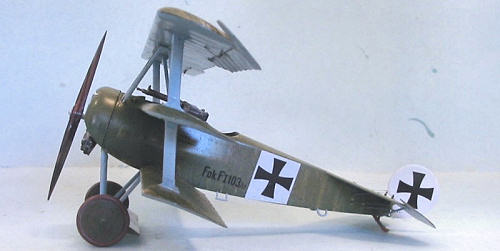 One
can generate a near-religious controversy when it comes to exactly what the
markings were for this airplane. I am a long-term member of the Church of the
Green Cowl and White Rudder, as you can see here, and consider those in the
Church of the Yellow Cowl and Rudder to be heretics. Whichever side of this
great divide you come down on, this is a great kit that makes up into an
accurate representation of a famous airplane, with only a bit of “some modeling
skill required.” Even the “multi-wing challenged” can create a successful model
with this kit.
One
can generate a near-religious controversy when it comes to exactly what the
markings were for this airplane. I am a long-term member of the Church of the
Green Cowl and White Rudder, as you can see here, and consider those in the
Church of the Yellow Cowl and Rudder to be heretics. Whichever side of this
great divide you come down on, this is a great kit that makes up into an
accurate representation of a famous airplane, with only a bit of “some modeling
skill required.” Even the “multi-wing challenged” can create a successful model
with this kit.
Review kit courtesy of Roden.
September 2006
If you would like your product reviewed fairly and fairly quickly, please contact the editor or see other details in the Note to Contributors.